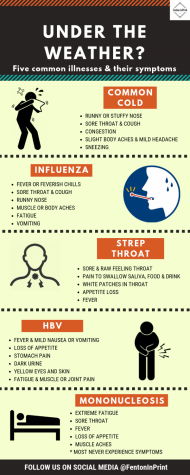Feeling under the weather? You may have this
April 10, 2019
Netflix plays on the television screen, watched with tired eyes while wrapped in blankets and sweating, despite feeling like an iceberg in Antarctica. With seasons changing and the moisture content in the air constantly dropping or rising, immune systems have to battle repeatedly against shifting environments. Often, people are caught off guard by sudden illnesses and infections that could have easily been prevented.
Ranked number one on the charts for “most common illnesses in America” is the common cold and flu, according to Urgent Medical Center. The common cold arises when the immune system works to fight off a virus; this cannot be prevented, and often occurs with changing seasons. According to Healthy Schools Campaign, acute illnesses, such as a cold or flu virus, stand as one of the top reasons kids miss on average a week of school every year.
Similar to a cold, the flu (influenza), begins with a virus, though respiratory-based, can be prevented through vaccinations. However, because of the constant mutation of cells and viruses, some cases cannot be prevented because doctors are unsure of which strand to use as a vaccination. Common colds and the influenza virus share several early symptoms, only the intensity of those symptoms differ. Simply washing your hands regularly and not touching your face are easy ways to keep contagious viruses at bay.
Second-in-line is strep throat, according to Urgent Medical Center. Strep throat is a bacterial infection of the throat and tonsils, wherein the bacteria thrives in throat and nose regions. This infection, like many others, spreads through close contact of bacteria in the air from sneezes and coughs or when your mouth, nose or eyes comes in contact with the bacteria of an already infected person. Unfortunately, there is no surefire way to protect oneself from obtaining the bacteria and inflammatory conditions.
One illness that is often overlooked and not talked about is the Hepatitis B virus (HBV). HBV is an infection and inflammation of the liver transmitted through blood and bodily fluids; direct contact with blood and sharing needles are only two examples. Though not considered a “sickness” (such as influenza), one in three people are living with it today as a chronic illness, according to the Hepatitis B Foundation. While HBV is completely preventable and treatable, roughly one million people die each year because they fail to go in for HBV testing, because the liver is an organ nobody can live without. The liver performs functions such as (but not limited to): storing vitamins and sugars to feed the body, clears waste products from the blood, and controls cholesterol, all vital for health.
Also known as “mono,” mononucleosis is an illness caused by the Epstein-Barr virus, which is spread through saliva. This illness is one of the most popular viruses to go around in schools among friends, according to Princeton University. Because symptoms remain dormant for about one to two months, there is no way to validate a specific medication. In fact, about 90 percent of adults have had mono, but only 20 percent know they had it, according to Princeton University.
For a quick (as possible) recovery, healthy eating, avoiding alcohol and getting plenty of rest are the best things for your body against the virus.
With roughly 1200 people in Fenton High, the common cold and flu, as well as strep throat, are the most popular illnesses to pass through. To slow the spread of these viruses, wash hands frequently, like before eating food and after using the restroom and eat a colorful range of foods every day. Investing time into health now can pay off later when it seems everyone else is under the weather.










